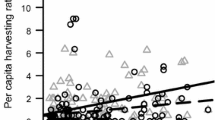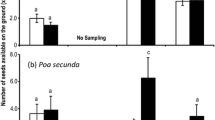Summary
The influences of Colorado pinyon pine (Pinus edulis) cone crop size, cone and seed weight, cone length, number of seeds per cone, number of viable seeds, and percent viable seeds on the foraging behavior of avian seed dispersal agents were examined in field and laboratory settings. In the field, there was a significant positive relationship between cone number per tree and both the absolute number of cones and the percentage of the cone crop from which seeds were harvested. Cone weight and the number of viable seeds were also significantly related to seed harvest intensity. Laboratory experiments examined the relationship between crop size and cone characters on seed harvest by 18 Clark's Nutcrackers (Nucifraga columbiana). Nutcrackers were offered a choice of two tree types: one with 20 cones attached, and another with 10 cones attached. Significantly more birds chose to remove seeds first from the tree with 20 cones than the tree with 10 cones. In timed trials, they also harvested seeds from significantly more cones on the tree with the higher cone density. In the laboratory, cones chosen for seed removal by the nutcrackers had significantly more viable seeds, more seeds, and were longer compared to cones that were not chosen. Such discriminatory foraging behavior may increase avian foraging efficiency and result in differential reproductive success of pinyon pines. This behavior may therefore influence the evolution of pinyon pine reproductive traits.
Similar content being viewed by others
References
Atsatt PR (1970) The population biology of annual grassland hemiparasites. II. Reproductive patterns in Orthocarpus. Evolution 24:598–612
Atsatt PR, Strong DE (1970) The population biology of grassland hemiparasites. I. The host environment. Evolution 24:278–291
Atsatt PR, Guldberg LD (1978) Host influence on floral variability in Orthocarpus densiflorus (Scrophulariaceae). Plant Syst Evol 129:167–176
Benkman CW, Balda RP, Smith CC (1984) Adaptations for seed dispersal and the compromises due to seed predation in limber pine. Ecology 65:632–642
Charnov EL (1976) Optimal foraging: the marginal value theorem. Theoret Pop Biol 9:129–136
Clark DA, Clark DB (1981) Effects of seed dispersal by animals on the regeneration of Bursera graveolens (Burseraceae) on Santa Fe island, Galapagos. Oecologia 49:73–75
Conover WJ (1980) Practical Nonparametric Statistics. Second edition. Wiley
Courtney SP, Manzur MI (1985) Fruiting and fitness in Crataegus monogyna: the effects of frugivores and seed predators. Oikos 44:398–406
Davidar P, Morton ES (1986) The relationship between fruit crop sizes and fruit removal rates by birds. Ecology 67:262–265
Herrera CM (1981) Fruit variation and competition for dispersers in natural populations of Smilax aspera. Oikos 36:51–58
Herrera CM (1982) Defense of ripe fruit from pests: its significance in relation to plant-disperser interactions. Am Nat 120:218–241
Herrera CM (1988) The fruiting ecology of Osyris guadripartita: Individual variation and evolutionary potential. Ecology 69:233–249
Horvitz CC, Schemske DW (1988) Demographic cost of reproduction in a neotropical herb: an experimental field study. Ecology 69:1741–1745
Howe HF, Primack RB (1975) Differential seed dispersal by birds of the tree Caeseria nitida (Flacourtiaceae). Biotropica 7:278–283
Howe HF (1977) Bird activity and seed dispersal of a tropical wet forest tree. Ecology 58:539–550
Howe HF (1979) Fear and frugivory. Am Nat 114:925–931
Howe HT (1981) Dispersal of a neotropical nutmeg (Viola sebifera) by birds. Auk 98:88–98
Howe HF, DeSteven D (1979) Fruit production, migrant bird visitation, and seed dispersal of Guarea glabra in Panama. Oecologia 39:185–196
Howe HF, Estabrook GF (1977) On interspecific competition for avian dispersers in tropical trees. American Naturalist. 111:817–832
Howe HF, Vande Kerckhove GA (1979) Fecundity and seed dispersal of a tropical tree. Ecology 60:180–189
Howe HF, Vande Kerckhove GA (1981) Removal of wild nutmeg (Virola surinamensis) crops by birds. Ecology 62:1093–1106
Hutchins HE, Lanner RM (1982) The central role of Clark's nutcracker in the dispersal and establishment of whitebark pine. Oecologia 55: 192–201
Janzen DH (1970) Herbivores and the number of tree species in tropical forests. Am Nat 104:501–528
Janzen OH (1972) Escape in space by Sterculia apetala seeds from the bug Dysdercus fasciatus in a Costa Rican deciduous forest. Ecology 53:350–361
Kamil AC, Balda RP (1985) Cache recovery and spatial memory in Clark's nutcracker (Nucifraga columbiana). J Exp Psych: Anim Behav Proc 11:95–111
Lanner RM (1980) Avian seed dispersal as a factor in the ecology of limber and whitebark pines. Proc Sixth North Am For Biol Workshop, Univ. of Alberta, Edmonton, Alberta, Canada
Lanner RM, Vander Wall SB (1980) Dispersal of limber pine seeds by Clark's nutcracker. J For 1980, 637–639
Ligon JD (1978) Reproductive interdependence of pinyon jays and pinyon pines. Ecol Monogr 48:111–126
Linhart YB, Mitton JB (1985) Relationships among reproduction, growth rates, and protein heterozygosity in ponderosa pine. Am J Bot 72:181–184
MacArthur RH, Pianka ER (1966) On optimal use of a patchy environment. Am Nat 100:603–609
McNamara JM (1982) Optimal patch use in a stochastic environment. Theoret Popul Biol 21:269–288
Moore LA, Willson MF (1982) The effect of microhabitat, spatial distribution, and display size on dispersal of Lindera benzoin by avian frugivores. Can J Bot 60:557–560
Murray KG (1987) Selection for optimal fruit-crop size in bird-dispersed plants. Am Nat 129:18–31
Paul NK (1978) Genetic architecture of yield and components of yield in mustard (Brassica Juncea (L.) Czern and Coss.). Theor Appl Genet 53:233–237
Pyke GH, Pulliam HR, Charnov EL (1977) Optimal foraging: a selective review of theory and tests. Quart Rev Biol 52:137–154
Schaal BA, Levin DA (1976) The demographic genetics of Liatris cylindracea (Michx. (Compositae)). Am Nat 110:191–206
Stapanian MA (1982) A model for fruiting display: seed dispersal by birds for mulberry trees. Ecology 63:1432–1443
Tomback DF (1978) Foraging strategies of Clark's nutcracker. Living Bird 16:123–161
Tomback DF (1982) Dispersal of whitebark pine seeds by Clark's nutcracker: a mutualism hypothesis. J Anim Ecol 51:1–46
Tomback DF, Kramer KA (1980) Limber pine seed harvest by Clark's nutcracker in the Sierra Nevada. Condor 82:467–468
Vander Wall SB, Balda RP (1977) Coadaptations of the Clark's nutcracker and pinon pine for efficient seed harvest and dispersal. Ecol Monogr 47:89–110
Vander Wall SB (1988) Foraging of Clark's nutcracker (Nucifraga columbiana) on rapidly changing pine seed resources. Condor 90:621–631
Vander Kloet SP, Cabilio P (1984) Annual variation in seed production in a population of Vaccinium corymbosum. Bull Torrey Bot Club 111:483–488
Whitham TG, Mopper S (1985) Chronic herbivory: impacts on architecture and sex expression in pinyon pine. Science 228: 1089–1091
Zar JH (1974) Biostatistical Analysis. Prentice Hall
Author information
Authors and Affiliations
Rights and permissions
About this article
Cite this article
Christensen, K.M., Whitham, T.G. & Balda, R.P. Discrimination among pinyon pine trees by Clark's Nutcrackers: effects of cone crop size and cone characters. Oecologia 86, 402–407 (1991). https://doi.org/10.1007/BF00317608
Received:
Accepted:
Issue Date:
DOI: https://doi.org/10.1007/BF00317608




